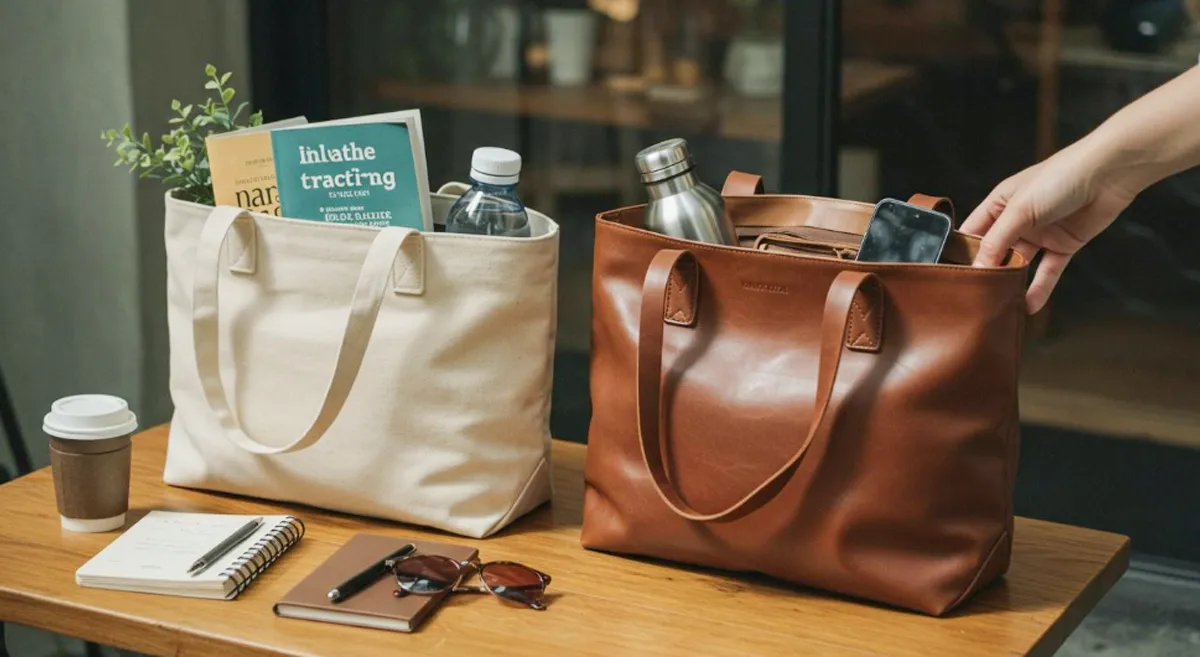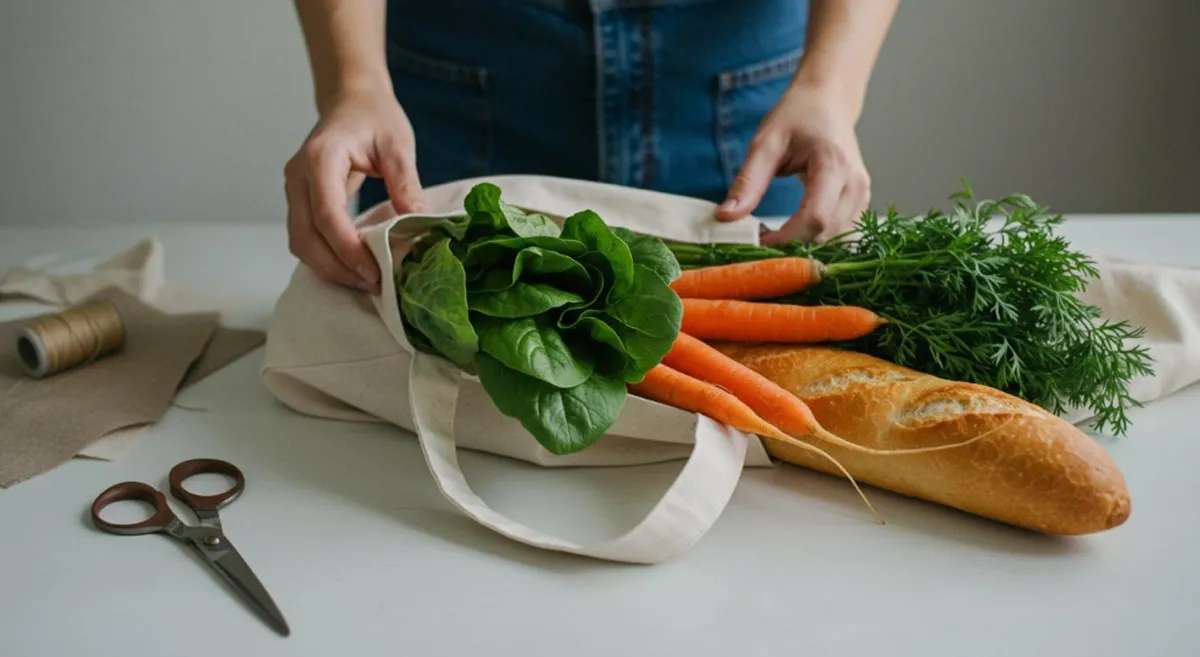Ready to make eco-friendly shopping bags at home? With a few basic tools and sturdy fabric, you can stitch a reusable tote in an afternoon. Every bag you make replaces dozens of single-use plastics and keeps your errands simple.
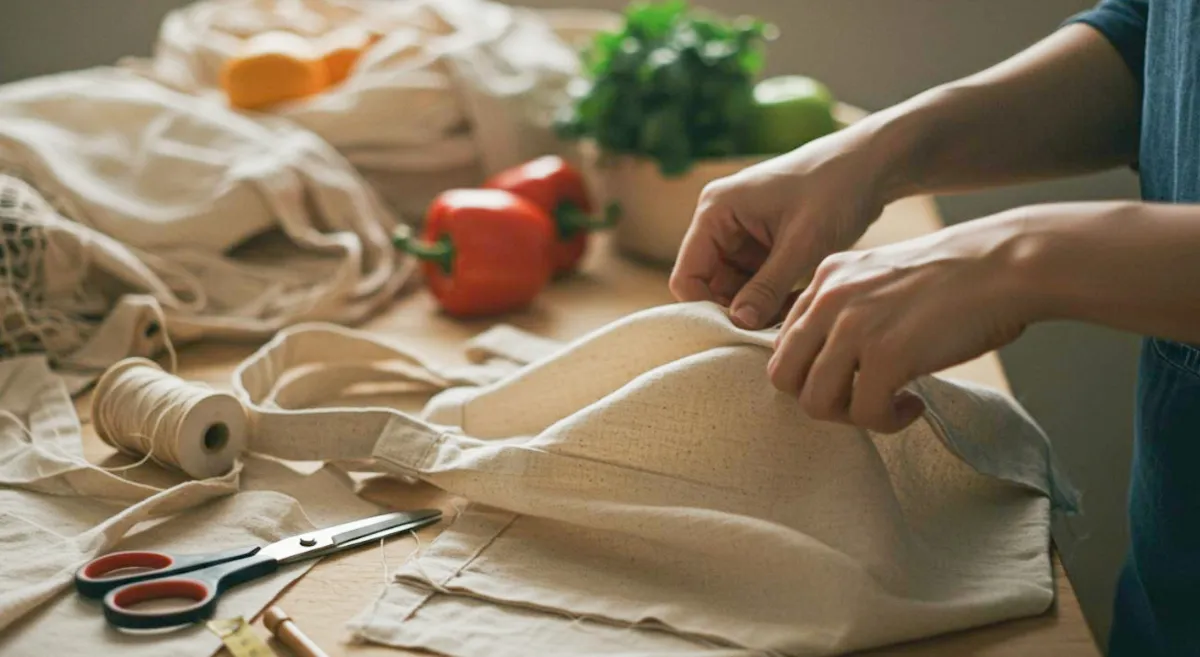
Plastic bags clog rivers and harm wildlife, which is why many countries now restrict or ban them. The smart move is to choose materials you will use for years, not weeks—think cotton canvas, recycled PET, deadstock denim, or upcycled T-shirts. Pick a weight that suits groceries, reinforce the handles, and cut pieces to minimize offcuts. In the steps below, you will measure, cut, and sew a durable bag you will actually reach for—simple, tidy, and truly sustainable.
Key Takeaways
- Making eco-friendly shopping bags helps cut down plastic waste. It also helps protect the environment.
- Pick fabrics like cotton, canvas, or jute. These are strong and break down easily.
- You can use old t-shirts and fabric scraps. These can be turned into shopping bags.
- Follow easy steps to sew or not sew your bags. This makes it simple for everyone.
- Add decorations and pockets to your bags. This makes them more useful and stylish.
- Wash and take care of your bags often. This keeps them clean and helps them last longer.
- You can turn plastic bags into reusable bags. This helps lower waste and gives you strong bags.
- Be creative and ask friends and family to help. Making eco-friendly bags together supports sustainability.
Materials
Before you start making your own eco-friendly shopping bag, you need to gather the right materials. Picking the best fabric and tools helps your bag last longer and stay kind to the planet.
Fabrics
You have many choices for fabrics. Some are new and natural, while others come from recycled items. Here’s a quick look at some popular options:
| Fabric | Biodegradable | Renewable | Recycled Options |
|---|---|---|---|
| Cotton | Yes | Yes | No |
| Canvas | Yes | Yes | No |
| Jute | Yes | Yes | No |
| Recycled Polyester | No | No | Yes |
| Nylon | No | No | No |
| Hemp | Yes | Yes | No |
Cotton
Cotton feels soft and is easy to sew. You can wash it many times. Cotton bags break down in nature, so they do not harm the earth. If you want a simple and classic bag, cotton is a great pick.
Canvas
Canvas is thicker than cotton. It holds heavy items and lasts a long time. You can use canvas for shopping bags that need to carry books, groceries, or even gym gear.
Linen
Linen comes from flax plants. It feels light and dries fast. Linen bags look stylish and work well for carrying bread, fruits, or veggies.
Tip: Banana fiber fabric is another smart choice. It comes from tree stems that people usually throw away. This fabric is strong, soft, and even resists water and tearing.
Recycled Options
You do not need to buy new fabric. You can use things you already have at home. This saves money and keeps waste out of landfills.
Old T-Shirts
Old cotton T-shirts make great shopping bags. They feel soft and you can wash them easily. T-shirt bags work best for light groceries or quick trips. You can get creative by cutting and sewing them in different ways. For example:
- Turn your shirt inside out and sew a zigzag stitch across the bottom.
- Add stitches at the corners for extra strength.
- Cut off the sleeves and neck to make handles.
- Sew across the top to create a strap.
- Trim extra fabric and turn the bag right side out.
Plastic Bags
You can upcycle plastic bags by fusing them together with heat. This makes a thicker, reusable material. These bags are not as strong as canvas, but they help reduce plastic waste.
Fabric Scraps
Do you have leftover fabric from old clothes or sewing projects? Gather these scraps and stitch them together. Patchwork bags look unique and help you use every last bit of fabric.
Using recycled materials like old T-shirts and fabric scraps is a smart way to make bags for light shopping. These bags may not be as strong as store-bought ones, but they are perfect for carrying snacks, books, or a few groceries.
Tools
You do not need fancy tools to make a shopping bag. Here are the basics:
Needles
A sharp needle helps you sew fabric by hand. Pick a needle that matches your fabric’s thickness.
Thread
Strong thread keeps your bag from falling apart. Cotton or polyester thread works well for most fabrics.
Scissors
Sharp scissors make cutting fabric easy. Use fabric scissors if you have them, so your cuts stay neat.
Sewing Machine
A sewing machine helps you finish your bag faster. It also makes strong stitches. If you do not have a machine, you can sew by hand.
Gather your materials before you start. This makes the whole process smoother and more fun!
How to Make Eco Friendly Shopping Bags
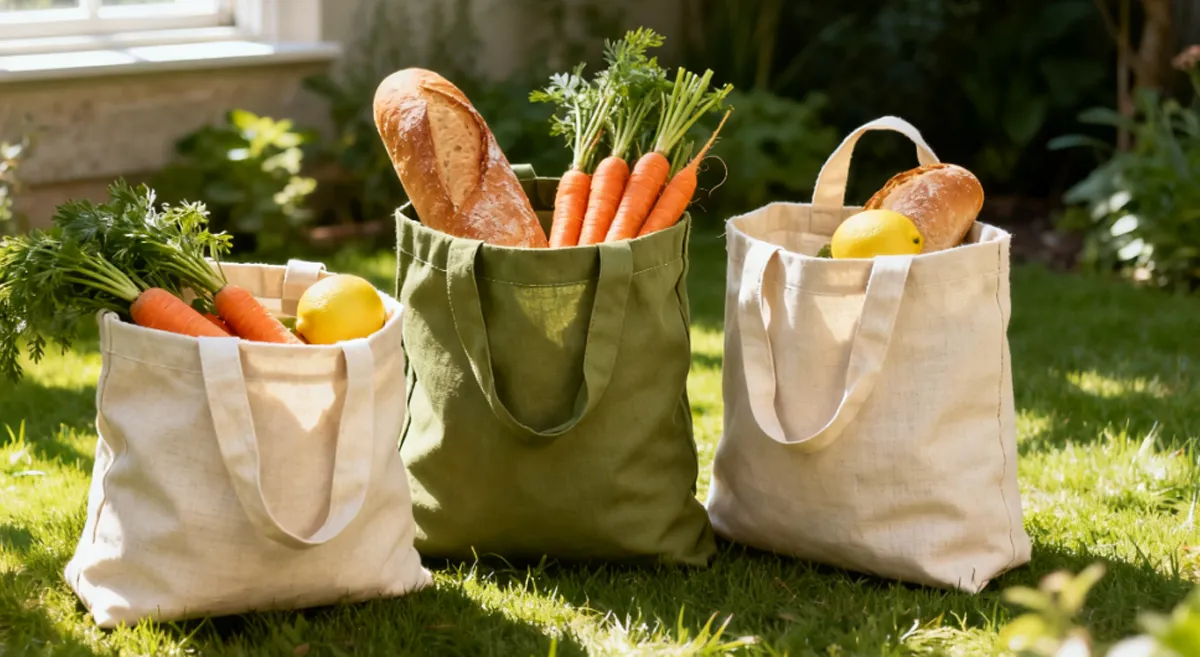
Ready to start your own eco-friendly shopping bag project? You can follow these simple steps and create a sturdy bag that lasts for years. Making your own bag saves money and helps the planet. Here’s how to make eco friendly shopping bags at home.
Cutting Fabric
Measuring
First, you need to measure your fabric. Standard shopping bags work well with panels that measure about 13 x 15 inches. If you want a larger bag, you can use 14 x 16 inches. Check the table below for quick reference:
| Panel Size (inches) | Gusset Length (inches) | Fabric Width (inches) |
|---|---|---|
| 13 x 15 | 43 | 45 |
| 14 x 16 | 46 | Not suitable |
You can use cotton, canvas, or even old T-shirts. Lay your fabric flat and mark the measurements with chalk or a washable marker.
Cutting
Grab your scissors and cut out two panels for the front and back. If you want a gusset (the strip that goes around the sides and bottom), cut a long piece that matches the length in the table. Make sure your cuts are straight. Neat edges help your bag look professional and last longer.
Sewing
Outer Fabric
Place the two panels together with the right sides facing each other. Pin the edges so the fabric stays in place. Sew down one side, across the bottom, and up the other side. Leave the top open. If you want extra strength, use heavier weight fabrics or double layers. You can also add a gusset by pinning it around the edges of one panel and sewing it in place before attaching the other panel.
Tip: Double layers and strong fabrics like canvas or ripstop nylon make your bag more durable. Recycled materials, such as old shower curtains, can also add strength.
Trim any loose threads and turn the bag right side out. Your basic bag shape is ready.
Lining
Cut lining pieces the same size as your outer panels. Sew the lining together, but leave a small gap at the bottom. Slip the lining inside your outer bag, matching the top edges. Pin them together and sew around the top edge. Turn the bag right side out through the gap in the lining. Close the gap with a simple stitch.
If you want to prevent fraying, use a zigzag stitch along the raw edges. This step helps your bag last longer, especially after many washes.
Handles
Attaching
Handles need to be strong and comfortable. Cut two strips of fabric, each about 4 inches wide and 26 inches long. For extra strength, use batting or interfacing inside the handles. Baste the fabric to the batting with glue, pins, or by ironing. Fold each strip in half lengthwise and sew along the long edge to make a tube. Turn the handles right side out and top stitch to secure the batting.
Pin the raw edges of the handles to the top of your bag. Make sure the handles are evenly spaced. Sew the handles in place using a ¼ inch seam. Secure the handles inside the bag for extra durability.
Reinforcing
You want your bag to carry heavy groceries without tearing. Reinforce the bottom by centering interfacing or faux leather on the back of your fabric. Apply double adhesive tape along the long edges, then attach the faux leather to the interfacing. Tape the interfaced piece to the center of your bag panel and top stitch close to the edges.
Pro Tip: Top stitch around the top of the bag after attaching the handles. This step secures the seam and makes your bag look neat.
Now you know how to make eco friendly shopping bags that are strong and reliable. You can use these bags for years, saving money and reducing waste. Many stores charge for plastic bags, so your homemade bag helps you avoid extra costs.
If you want to make your bag even stronger, add a gusset and reinforce the bottom. Use double layers and sturdy fabrics. Secure the handles with extra stitching. Your bag will last longer and carry more weight.
How to make eco friendly shopping bags is easy when you follow these steps. You can customize your bag with different fabrics and handle styles. Try making a few bags for your family and friends. You’ll see how simple and fun it is to create something useful and sustainable.
No-Sew Methods
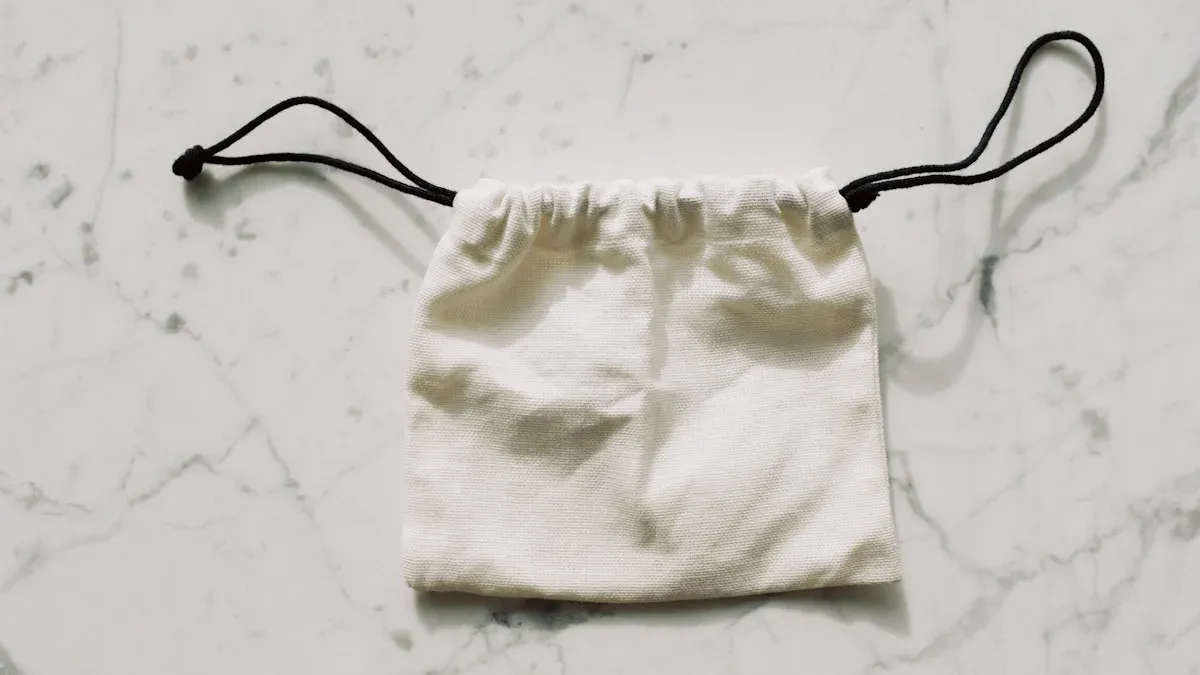
You might not have a sewing machine or needle at home. That’s okay! You can still make eco-friendly shopping bags with simple no-sew methods. These projects use everyday items like old t-shirts and paper. You’ll find these steps easy to follow, even if you’ve never made a bag before.
T-Shirt Bag
Old t-shirts can turn into handy shopping bags. You don’t need to sew anything. You just need scissors and a little creativity.
Cutting Sleeves
Start with a clean t-shirt. Lay it flat on a table. Use sharp scissors to cut off both sleeves. Cut around the neck to make a scoop shape. This will be the opening of your bag. You can make the scoop deep or shallow, depending on how big you want the handles.
Stitching Bottom
You don’t need thread for this part. Cut small slits along the bottom edge of the shirt, about one inch apart. Tie each pair of slits together in a knot. Work your way across the bottom until you reach the other side. This closes the bottom of your bag. If you want, you can use small strips of fabric to tie decorative handles at the top.
Tip: No-sew t-shirt bags work best for light groceries or books. They are not as strong as sewn bags because they lack reinforced seams. If you need a bag for heavier items, try a sewn method from the “How to Make Eco Friendly Shopping Bags” guide.
Origami Paper Bag
Paper bags are great for quick trips or carrying snacks. You can make one with just a sheet of sturdy paper and some ribbon.
Folding Steps
Follow these steps to create your own origami paper shopping bag:
- Fold the paper in half to make a crease. Open it.
- Fold the paper diagonally in one direction. Open it.
- Fold diagonally in the other direction. Open it.
- Push the sides toward the center to form a triangle. Flatten it.
- Rotate the triangle so the flat side faces away from you. Fold about 1.5 inches from the tip.
- Take the right point and fold it to align with the first fold. Fold it in half.
- Repeat with the left point.
- Flip the triangle. Fold the right point toward the center, lining up the edge. Fold it in half.
- Repeat with the left point.
- Fold the points inside the bag and glue them down.
- Open the bag into a box shape.
Reinforcing
Measure the bottom of your box. Cut a rectangle of paper that matches the width and is twice the length. Fold it in half and glue it to the inside bottom for extra strength. Punch two holes on each side for handles. Cut ribbon pieces, heat the edges to stop fraying, and insert them into the holes. Glue the ribbons in place.
Note: Origami paper bags break down naturally and can be recycled. They are more sustainable than snack bags made from layered materials, which often end up in landfills.
You now know two easy ways to make shopping bags without sewing. These methods help you reuse materials and reduce waste. Try making a few for your next shopping trip. You’ll see how simple it is to follow the steps in the “How to Make Eco Friendly Shopping Bags” guide.
Alternatives
Looking for more ways to make eco-friendly shopping bags? You can try upcycling plastic bags or using natural fibers like hemp and jute. Both options help you cut down on waste and create sturdy, reusable bags.
Plastic Bag Upcycling
You probably have a pile of plastic bags at home. Instead of tossing them, you can turn them into a strong, reusable shopping bag. This method gives plastic bags a second life and keeps them out of landfills.
Cutting
Start by gathering your plastic bags. Use scissors to trim off the handles and seams. Flatten each bag so you have smooth sheets of plastic. This step helps you stack the bags neatly for the next part.
Ironing
Now, you’ll fuse the plastic layers together to make a thicker, more durable material. Here’s how you do it:
- Gather an iron, a heat-resistant surface, baking parchment paper, and your trimmed plastic bags.
- Set your iron to a medium setting. Make sure you work in a well-ventilated area.
- Place a layer of parchment paper on your surface. Lay down a plastic bag sheet, then cover it with another piece of parchment paper.
- Gently move the iron over the top layer. Check often to see if the plastic has fused. If you see crinkles, re-iron those spots.
- Add more plastic layers for extra strength. Repeat the fusing process until you reach the thickness you want.
- Trim the fused plastic into a rectangle. This will be the main part of your bag.
Upcycling plastic bags into reusable shopping bags helps lower your carbon footprint. When you reuse plastic bags, you use less energy than making new cloth or paper bags. These upcycled bags also work well as garbage liners or for sorting waste, which supports recycling and reduces trash.
Sewing Together
Take your fused plastic rectangle and fold it in half. Sew the sides together, leaving the top open. You can use a sewing machine or a strong needle and thread. Attach handles made from extra fused plastic or thick ribbon. Now you have a waterproof, reusable bag!
Hemp and Jute
Natural fibers like hemp and jute make strong, eco-friendly bags. These materials break down in nature and come from renewable sources.
| Aspect | Hemp | Jute |
|---|---|---|
| Durability | Superior strength and durability | More suitable for short-term uses |
| Sustainability | Regenerative farming, lower pesticide use | More water-intensive, monoculture farming |
| Cost-effectiveness | Generally more expensive | More cost-effective for bulk uses |
Cutting
Gather your supplies: hemp or jute cord, scrap wood for a loom, and some screws or nails. Set up your loom by placing screws into a board to make a frame. This frame will help you weave the bag.
Assembly
- Tie a larks head knot to start your net. Decide how big you want the holes.
- Keep tying knots to form the net structure. Make sure the knots are tight for strength.
- When your net is big enough, secure the ends with knots. Trim any extra cord for a neat look.
- Fold the net in half to create the bag shape. Attach handles using more cord or fabric.
Hemp bags last a long time and can carry heavy loads. Jute bags cost less and work well for lighter shopping. Both options help you avoid plastic and support a cleaner planet.
Customization
You can make your eco-friendly shopping bag stand out with a few creative touches. Customizing your bag lets you show off your style and add features that make shopping easier. You don’t need fancy tools or expensive supplies. You just need a little imagination and some basic materials.
Decoration
Decorating your bag is fun and simple. You can use paint, embroidery, or other easy techniques. Here are some popular ways people decorate their reusable bags:
- Fabric Painting: Grab some fabric paints, brushes, and stencils. You can paint flowers, shapes, or even your favorite cartoon characters. Painter’s tape helps you make clean lines. If you want a bold look, try painting abstract designs.
- Iron-On Transfers: These give you crisp and colorful images. You just need an iron and a transfer sheet. Place the design on your bag, press with the iron, and peel off the backing. Your bag now has a bright new look.
Tip: Let your painted bag dry completely before you use it. This keeps the colors from smudging.
Paint
Painting your bag is easy. Lay your bag flat on a table. Slide a piece of cardboard inside so the paint doesn’t bleed through. Use fabric paint for best results. Draw your design with a pencil first, then fill it in with paint. You can use stencils for neat shapes or freehand for a personal touch. Let the paint dry for at least 24 hours.
Embroidery
Embroidery adds texture and color. You can stitch your name, a flower, or a simple pattern. Use embroidery floss and a needle. Draw your design on the bag with a washable marker. Thread your needle and start stitching along the lines. Try basic stitches like backstitch or running stitch. Embroidery makes your bag unique and lasts through many washes.
Pockets
Adding pockets to your shopping bag makes it more useful. You can keep your phone, keys, or coupons in a safe spot. There are many types of pockets you can try:
- Zippers
- Inside pockets
- Buttons
- Ropes
- Straps
Adding
To add a pocket, cut a small piece of fabric. Fold the edges under and sew it onto the inside or outside of your bag. For a zipper pocket, sew the zipper onto the pocket piece first, then attach it to the bag. You can use buttons or Velcro to close the pocket. Ropes and straps work well for holding water bottles or umbrellas.
Note: Inside pockets keep your valuables hidden. Outside pockets give you quick access to small items.
Placement
Think about where you want your pockets. Inside pockets are great for security. Outside pockets are easy to reach. Place pockets near the top for things you grab often. Put larger pockets at the bottom for bulkier items. You can even add several pockets in different spots for extra organization.
Customizing your eco-friendly shopping bag makes it special and practical. Try different decorations and pocket styles to create a bag that fits your needs and personality.
Care
Taking care of your eco-friendly shopping bags helps them last longer and keeps them looking fresh. With a few simple habits, you can keep your bags clean, fix small problems, and store them the right way.
Washing
You want your reusable bags to stay clean and safe for groceries. Here’s how you can wash them without causing damage:
- Empty and Spot Clean: Take everything out of your bag. Use a damp cloth or a little mild detergent to wipe away any stains or spills.
- Prepare for Washing: Turn your bag inside out. Check for any care labels that might have special instructions.
- Wash the Bag: If you use a washing machine, pick a gentle cycle with cold water and mild detergent. For delicate fabrics, hand wash in cold water.
- Dry the Bag: Let your bag air dry completely. Keep it out of direct sunlight and away from heaters to prevent fading or shrinking.
- Iron if Needed: If your bag looks wrinkled, use a low-heat iron on the inside.
Tip: Always let your bag dry fully before you use or store it. This stops mold and keeps your bag smelling fresh.
Repair
Sometimes your bag gets a tear or the seams come loose. You can fix most problems at home with a few easy steps:
- Clean the damaged area with mild soap and warm water. Let it dry all the way.
- Trim any loose threads or frayed edges around the tear.
- Pick your repair method:
- For small holes, cut a fabric patch and glue or sew it over the spot.
- For torn seams, use a needle and strong thread to stitch them back together.
- For bigger holes, use both a patch and stitches for extra strength.
- Hold the patch in place with pins or clips while you work.
- Use small, even stitches. Double the thread if your bag carries heavy things.
- Let any glue dry for a full day, or tie off your thread tightly when you finish sewing.
You can give your bag a second life with a simple repair. This saves money and keeps waste out of landfills.
Storage
Storing your bags the right way keeps them clean and ready for your next trip. Here are some best practices:
- Always clean and dry your bags before putting them away. This stops mold, mildew, and bad smells.
- Store your bags in a cool, dry place. Avoid folding them too tightly so they keep their shape.
- Don’t leave your bags in the trunk of your car. The heat and moisture can cause bacteria and mold to grow.
Keeping your bags clean and dry means they’ll last longer and stay safe for your groceries. A little care goes a long way!
Conclusion
You now know how to make eco friendly shopping bags in many ways. You can sew, use no-sew tricks, or upcycle old things. Using reusable bags helps the earth and saves you money. Here are some main benefits:
| Benefit Description | Source |
|---|---|
| Less petroleum used for plastic bags | Rivers et al., 2017; Taylor and Villas-Boas, 2016; Zen et al., 2013 |
| Lower packaging costs in California | UNEP, 2018a |
| Fewer single-use bags in Rwanda | Larsen and Venkova, 2014 |
| Better public health in Kenya | Njeru, 2006; UNEP, 2018a |
Try out different fabrics and add your own designs. Show your bags to friends and family. You can get others excited about using eco friendly bags too. Use green materials, join local events, or work with groups in your area. If you want more choices, our company has many eco-friendly bags. We offer non-woven, canvas, cotton, and more. You can also get bags made just for you with OEM and ODM options.
FAQ
How strong are homemade eco-friendly shopping bags?
You can carry groceries, books, or clothes in most homemade bags. If you use sturdy fabric like canvas or double layers, your bag will last longer. Reinforce the handles and seams for extra strength. Always test your bag with heavy items before you use it for shopping.
Can I wash my reusable shopping bag in the washing machine?
Yes, you can wash most fabric bags in the machine. Use cold water and a gentle cycle. Air dry your bag to prevent shrinking or fading. If your bag has decorations or special materials, check the care label first. Spot clean delicate bags with a damp cloth.
What materials work best for beginners?
Cotton and old t-shirts are easy to cut and sew. Canvas is a good choice if you want a stronger bag. You can also use fabric scraps for patchwork designs. If you want a no-sew project, try using a t-shirt or sturdy paper. These materials are simple and forgiving.
How do I make my bag look unique?
You can decorate your bag with fabric paint, iron-on patches, or embroidery. Add pockets for extra storage. Try using colorful fabrics or mixing patterns. Personalize your bag with your name or favorite designs. Get creative and make a bag that shows your style.
Are no-sew bags as durable as sewn bags?
No-sew bags work well for light shopping or carrying books. Sewn bags with reinforced seams and strong handles last longer and hold heavier items. If you need a bag for groceries or heavy loads, choose a sewn method and use sturdy fabric.
Can I use recycled plastic bags to make a shopping bag?
Yes, you can fuse layers of plastic bags with an iron to create a thicker material. Sew the fused sheets together and add handles. This upcycling method keeps plastic out of landfills and gives you a waterproof bag. Always work in a ventilated area when fusing plastic.
What should I do if my bag gets a tear?
You can fix small holes with a fabric patch and glue or by sewing. For torn seams, use a needle and strong thread. Trim loose threads before you repair. Fixing your bag helps it last longer and keeps waste out of landfills. Regular repairs save you money.
How do I store my eco-friendly bags?
Clean and dry your bags before storing. Fold them loosely to keep their shape. Store in a cool, dry place away from sunlight. Avoid leaving bags in your car, since heat and moisture can cause mold. Keep a few bags near your door so you remember to use them.


